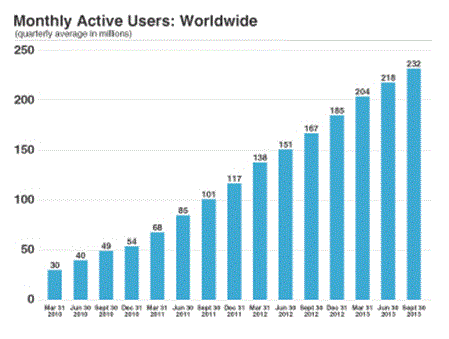 Twitter has to be one of the more interesting modern-day concepts: a platform where people from all over the world can share ideas, thoughts and breaking news in bite-sized portions of up to 140 characters.
Twitter has to be one of the more interesting modern-day concepts: a platform where people from all over the world can share ideas, thoughts and breaking news in bite-sized portions of up to 140 characters.
Apart from being a means for celebrities to interact with their followers, it is also used extensively by journalists, politicians, intellectuals and investment professionals to share their views and be challenged on them.
There is no doubting its impact on society and our lives, so it comes as no surprise that the interest in its listing (or, to use the US term, its initial public offering or IPO) is reaching fever pitch. Twitter is looking to raise US$1,7bn in capital on a valuation of around $17bn.
It is arguably the most interesting IPO of the year and certainly the most exciting IT listing since Facebook in 2012. Twitter, which is much smaller than Facebook, will be sure to learn from Facebook’s IPO flop: it was one of the few high-profile listings where the share traded below its IPO price (and stayed there for more than a year). Facebook and its bankers, Morgan Stanley, were heavily criticised for the way the IPO was handled.
Because of this, Twitter has already decided to list on the New York Stock Exchange, which could be construed as a slap in the face of the Nasdaq, the US exchange that has become synonymous with technology companies. The issues that Facebook shareholders had to endure during its IPO seem to have encouraged Twitter to opt for the Nasdaq’s older, more traditional competitor.
Another interesting choice has been to have Goldman Sachs as the underwriter and lead book builder for the listing. Many in the investment community blame Morgan Stanley, the underwriter and lead book builder for the Facebook IPO, for hyping its price up a couple of times before listing (due to rampant demand), leaving very little on the table for others. Let’s hope Twitter’s listing will be more professionally handled and the usual IPO “pop” happens.
But when it comes to valuation, Twitter does look rather expensive. It is listing on more than 25 times revenue and more than 10 times forward revenue, with no history of profit in its short, seven-year history. Even if you forecast profits to be $500m in two years (possible, but not likely), it is still a rather steamy 20 times its two-year forward earnings.
However, the power of Twitter and its growth has been staggering. At the end of September, it had almost 232m active users who generate more than 500m tweets a day. This is up from 30m users in March 2010 (see graph below). The revenue growth has been even more staggering. From a revenue base of $28m in 2010, it generated revenue of $422m for the nine months to September 2013. Some analysts have forecast revenue to top $1bn for the full year next year as it starts to monetise its platform through various advertising campaigns.

The really staggering thing is that Twitter is probably still in the infancy stage of its growth story. Pew Research estimates that 18% of US adults use Twitter, up from 8% three years ago, but still well below the 72% who use all social networking sites. Outside of the US, the growth potential is even greater. Twitter states in the prospectus that “in the future we expect our user growth rate in certain international markets, such as Argentina, France, Japan, Russia, Saudi Arabia and South Africa, to continue to be higher than our user growth rate in the US”. South Africa is mentioned despite doubling its users in the last year.
Although it is difficult to forecast a sustainable growth rate, the one thing Twitter does have on its side is a business model that is it is scaleable — the infrastructure that Twitter is built on does not require massive capital to grow. Revenue is almost all sourced from advertising and if revenue can grow at 30%/year for a number of years and it can contain costs, Twitter could be a very profitable company. Furthermore, while Twitter does seem expensive in absolute terms, relative to other social media companies it does look attractive:
[table id=52 /]
Moving beyond the financials, Twitter is more than just an IT company looking to raise capital. It is very much a revolutionary concept. Like the PC in the 1980s and the Web in 1990s, social media is the next step in the ever-evolving digital and information age.
Twitter, in its short existence, has already shown its power to extend boundaries, both economic and political. The upheaval in the Arab Spring was in part facilitated by Twitter’s ability to disseminate information quickly and broadly and draw large hordes of like-minded people to rise up together. History may attribute to Twitter the role of a significant contributor to facilitating the breaking down of barriers in society and promoting globalisation.
If you look at the sustainability of its business model, it also looks more attractive than some of its peers. Twitter is more than just a photo-sharing application between social circles; it is a way of sourcing news and information and finding interesting people to follow. It is unique in its ability to disseminate information quickly and is used extensively as a valuable medium of communication.
As usual with internet IPOs though, determining the right price is the difficult thing. But there is one thing that is sure to happen when Twitter when it lists later on Thursday: #TwitterIPO will be trending.
- Roy Topol is investment manager at Investec Wealth & Investment




